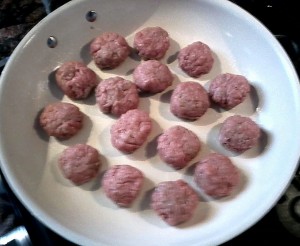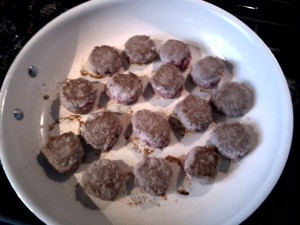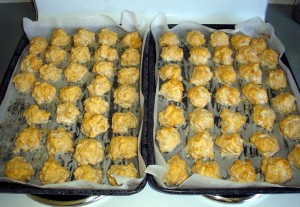Easy Home Cooked Cat Food
By Cheryl Craig, Laurie Goldstein and Lisa Provost
This is slightly adapted from a recipe by Dr. Jean Hofve in her book “What Cats Should Eat”. You can use a slow cooker, do it in a pot on the stove or in the oven as well. I use the Alnutrin supplement with eggshell calcium to balance it. When using this supplement you need to add liver. I don’t use Tyson liver, I prefer organic if you can find it or even Perdue is better as Tyson has had a lot of violations.
DISCLAIMER: (These meat amounts were based on an older measurement of Alnutrin, please check the Alnutrin package and website for proper meat measurements and dosing. This is just an example). 2 lbs. meat or poultry and 3 oz. of liver. You can use boneless skinless chicken or turkey thighs, lamb, veal, rabbit, any kind of boneless meat you think they might like. You can even mix them together at some point, like chicken & turkey, etc.; You can also add some hearts. Just make sure there are no nitrates in the meat and any sodium should be less than 100 mgs per serving. This is a very flexible recipe that can be used with any protein. It’s actually best to have at least three proteins in rotation. You can use some skin to add a little more fat and calories, or remove it for a leaner product. NEVER feed your pet cooked bones, even in small amounts. You can cook it with the bones, but make sure you remove them before you chop or puree it! Make sure to buy meat that is not “enhanced” with salt solution. You can tell if it is enhanced by checking the sodium content. It should not be more than 100mg per 4 oz serving. If you have limited freezer space, it makes more sense to prepare smaller batches. You can start with a 1lb. batch. Use 16 ounces (1lb.) of raw weight boneless/skinless chicken thighs and 1.5 ounces of liver. Add around 1/4 cup or slightly more of water per pound (try to stick o around ¼ cup of water. Too much will make it baby food mushy).
If your kitties become constipated it can be the eggshell calcium. Instead of using 1.5 ounces of liver per pound, try increasing it to two or even 2.5 ounces per pound (a total of four or five ounces of liver per 2 lbs of meat instead of 3 ounces). The Alnutrin uses eggshell as a source of calcium (and trace minerals). Too much calcium can be constipating; adding the extra phosphorus in the liver should help by lowering the Calcium:Phosphorus ratio. Please note, liver is high in vitamin A, a fat – not water – soluble vitamin. The typical recommendation for liver content in a prey model raw diet is 5%. In the absence of another secreting organ, like kidney, some increase the liver to 10%. Our reason for including the liver at 10% is simple: liver is not just high in vitamin A, it is high in taurine, and packed with many other amino acids, vitamins, and minerals. Our IBD cats have impaired GI systems, and are not as efficient at metabolizing nutrition from food. Using fresh, human grade food goes a long way to improving digestibility and thus bioavailability, but that doesn’t alter the fact that many of our IBD cats do not effectively access [all] the nutrients in the food.
Please note: If you are concerned about vitamin A toxicity due to “vitamin A build-up in their systems,” please know that the maximum upper limit of vitamin A in cat food as per the AAFCO is 750,000iu per kilogram of food (on a dry matter basis, “DMB”). This diet provides approximately 40,500iu of vitamin A per kilogram of food, which is approximately 5.4% of the safe upper limit recommendation. Even if you increase the liver as directed for managing constipation, the diet still contains less than 70,000iu of vitamin A per kilogram of food (less than 10% of the safe upper limit). These are very, very safe margins: the AAFCO has already taken into account the potential amount of fat in the diet (which increases vitamin A uptake); how cats metabolize vitamin A; and at what rate cats store vitamin A in their livers and kidneys. Of course, you can adjust the amount of liver in the recipe to your level of comfort. The AAFCO minimum recommended amount of vitamin A is 5,000iu per kilogram of food (on a dry matter basis). Targeting 2% liver provides about 9,700iu of vitamin A per kilogram of food (DMB) (1.3% of the maximum); 5% liver provides ~22,000iu of vitamin A per kg of food (DMB) (3% of the maximum); 7% liver provides ~30,000iu of vitamin A per kg of food (DMB) (4% of the maximum); and the 10% liver recommended here provides ~40,500iu of vitamin A per kg of food (DMB) (5.4% of the maximum).
If you decide to add heart, make sure to count that as your main meat measurements. All the meat must measure to 1 or 2 lbs. depending on how much you’re making (or at least close, it does not have to be exact, just as close as you can get it).


Cook 6-8 hours or until meat is very tender. Sometimes it’s less time, depending on if you cook on high or low. Mine can take as little as 4 hours. Remove meat and let cool until you can cut/tear it into chunks. Put in food processor with all the cooking liquid. Pulse until desired texture; from chunky to smooth pate. You will need to do this in batches, do not put all the meat and broth in at once. Do it a little at a time, especially if you’re doing larger batches. Only pulse for several seconds (I use the small chopping blade and pulse for around 3-5 seconds per time). Transfer to large mixing bowl. AGAIN, PLEASE SEE ALNUTRIN PACKAGING AND WEBSITE FOR PROPER MEAT AND ORGAN AMOUNTS AND DOSING INSTRUCTIONS! (Make sure mixture is cooled to room temperature before adding). You can only get Alnutrin at this website: www.knowwhatyoufeed.com/shop_online.html
Optional add in’s:
2 capsules (1000 mg) krill oil or Alaskan salmon oil
2 capsules plant based digestive enzymes
1 jar baby food pumpkin or squash (Beechnut only as Gerber has cornstarch)
Mix well and divide into portions in small containers. These will last you longer in the beginning because you’re only mixing it in and not feeding the whole thing. Defrost in refrigerator as needed. I started mine out by only adding a teaspoon at each meal and now I’m at 50% canned food and 50% homemade. I mix half and half at each meal. If they won’t eat it right away you can add freeze dried treats crumbled on top of it to entice. Just make sure there is no ground bone in it as that can constipate many kitties. Always switch their diet slowly!! Please see link at the top on how to switch foods slowly.
Making Cooked Homemade Food with EZcomplete fur Cats by Food Fur Life
By Laurie Goldstein
To order EZcomplete https://www.foodfurlife.com
Please note, no matter what recipe you follow to make homemade food, cooked or raw, we recommend introducing and having at least three different animal proteins in the diet to prevent sensitivities or food boredom. Whether you rotate daily, weekly, or monthly is up to you and your cat, but it is best to have options! Please introduce each new protein slowly and one-at-a-time.
The basic concept for making batches is very simple: prepare the boneless meat, recover the pan drippings. Let it cool, then chunk, chop or puree, add water, then evenly mix in the EZcomplete supplement. That’s it!
IMPORTANT NOTES FOR COOKED FOOD WITH EZcomplete:
1) EZcomplete fur Cats contains everything needed to balance BONELESS meat.
2) Cook ONLY the (boneless) meat. EZcomplete fur Cats is added AFTER the meat is cooked and cooled.
3) When using EZcomplete with cooked (boneless) meat, the amount of EZcomplete fur Cats to use is based on the RAW weight of the meat, prior to cooking.
3) When making cooked food with EZcomplete, as outlined in each method of cooking, it is VERY important to use all of the cooking water OR to recover the pan drippings to include in the food: important minerals and vitamins are contained in that water and those juices!
The Ingredients for Batches
Non-metric
Two pounds of boneless meat, chunked or ground. Weight is measured raw, not already cooked.
1 ½ cups of water. Adjust water content to your cat’s preference.
Scant 1/2 cup (do not pack the cup, the powder is measured loose – equivalent to 22 provided scoops of powder) of EZcomplete fur Cats. If you prefer to weigh the supplement for precise measurement, the amount to use with two pounds of meat is 53.3 grams of supplement.
Metric
One kilogram of boneless meat, chunked or ground. Weight is measured raw, not already cooked.
400mg of water. Adjust water content to your cat’s preference.
24 scoops of EZcomplete fur Cats (58.8 grams of supplement if you want to be precise).
Instructions for Cooking the Boneless Meat
Slow Cooker Method
Add the boneless meat and 1/4 cup of water per pound (1/2 – 3/4 cup of water per kilogram) to the slow cooker. Cook on low for 4 to 6 hours or on high for 3 hours.
Allow the meat to cool, then chop, cut, shred, or use a food processor to chop/grind to a consistency you (and your cat) like.
Use ALL of the water used for cooking the meat when mixing with the supplement. The cooking juices contain valuable minerals and nutrients.
Baking/Roasting
If you bake or roast the meat, retain/recover as much of the pan drippings as possible, these include valuable nutrients.
Baking/Roasting Instructions: Cook at 350 F (180C) for 20 minutes per pound (500g) of boneless meat, depending on the internal temperature you want to target. Reducing the internal temperature over time (cooking the meat less and less) can be used as a method to transition to raw if desired.
If using a roasting pan with an elevated rack for the boneless meat we recommend adding a bit of water to the bottom of the pan and then covering the entire thing with foil to retain the moisture. This makes it easier to recover the pan drippings. When the poultry or meat is done, please add the 1 ½ cups water (400g per kilogram of meat) that will be used to mix the meat with EZcomplete to the roasting pan and scrape all of the pan drippings into the water. Put meat and juices+water into a mixing bowl or food processor to cool.
If using a baking pan with the boneless meat flat on the surface, please opt for a pan that is not completely flat, as using water to recover the pan drippings will be difficult. When done, please use as much of the 1 1/2 cups of water (400g per kilogram of meat) as necessary to recover the pan drippings, and then add that and the balance of the water to the mixing bowl or food processor to cool.
TO FINISH MAKING THE FOOD:
Chop or shred the meat. Mix with the watery pan juices, and add the balance of the 1½ cups of water. Add the supplement, and mix thoroughly. You can add more water if needed or if your cat likes the food with more gravy or a bit “soupier.”
To make “ground” food (or to puree) if you don’t have a grinder for the meat, (whether raw or cooked & cooled), cut the boneless meat into small pieces appropriate to the size of your food processor (if cooked, wait until the meat has cooled). Add the watery juices. Pulse the food processor for a few seconds at a time to chunk/mince/”grind” to your cat’s desired consistency. Add the EZcomplete supplement and mix thoroughly. Again, you can add more water if needed to distribute the supplement evenly into the mixture or as desired as per your cat’s preference.
If using already ground meat, just add the cooled, cooked meat, juices and water to a mixing bowl and add the EZcomplete supplement. Mix thoroughly.
Portion and freeze!
No need to add digestive enzymes OR an omega 3: these are already included.
If using probiotics, these need to be added at meal time: freezer storage may kill the probiotic strains.
Meat sliders
By Cheryl Craig
You make little patties (any kind of ground meat should work fine) like you would for regular burgers, about 1 ½ inch in diameter and a little thick, maybe ½ inch. Brown them on both sides in a skillet. Non-stick works best as long as it’s not Teflon (which is toxic to pets). About a minute or two on each side, so they are medium rare. Let them cool and pop them in a freezer bag or container. Then take out what you need, and heat them in the microwave for about 30 seconds (from frozen) to defrost and slightly warm them. If they are too hot put a spoonful of cold water over them and break them up in smaller pieces. Makes a nice little snack or treat.


Chicken and Pumpkin Treats
Ingredients: Fresh, free-range or organic boneless chicken pieces, minced. Fresh steamed pumpkin (can also include other suitable veggies, ie carrots or sweet potato), mashed.
Method: Combine the minced raw chicken with a small quantity of the steamed pumpkin (to start with, I use about an 80% chicken to 20% vegetable ratio, increasing the pumpkin quantity a little more in subsequent batches). Mix thoroughly. Line a couple of baking trays with baking paper. Form balls of the mixture (mine are a bit smaller than a Ping-Pong ball), and place on the trays.
Bake for approximately 25 mins at 170 degrees C; turning partway  through, making sure they don’t brown. You may find that quite a bit of moisture comes out of the balls during cooking, which sort of “steams” them on the tray. I bake two oven trays worth at a time, and dole out one ball to each cat every 2-3 days, more often if stool consistency indicates the need.
through, making sure they don’t brown. You may find that quite a bit of moisture comes out of the balls during cooking, which sort of “steams” them on the tray. I bake two oven trays worth at a time, and dole out one ball to each cat every 2-3 days, more often if stool consistency indicates the need.
More links for homecooked foods (these don’t need grinders):
Cat food making pictorial and instructions:
www.catnutrition.org/pictorial.html
Dehydrating Dog Treats (can be done for cats as well, excellent instructions).
http://drjeandoddspethealthresource.tumblr.com/post/53521863975/dehydrating-dog-treats
Catsicles: Homemade Cat Treats for Summer
www.petfinder.com/cats/cat-nutrition/homemade-summer-cat-treat/
